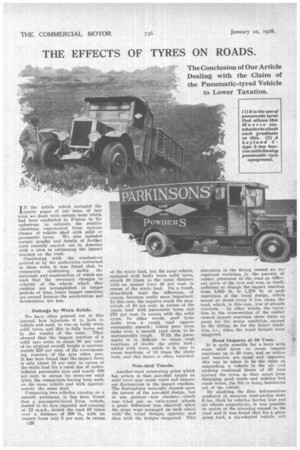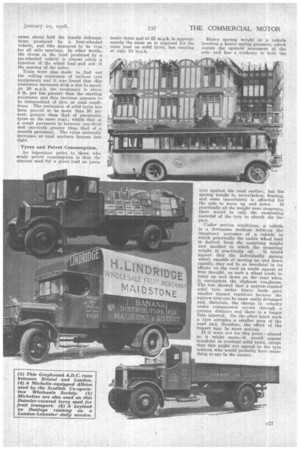THE EFFECTS OF TYRES ON ROADS.
Page 48

Page 49

If you've noticed an error in this article please click here to report it so we can fix it.
The Conclusion of Our Article Dealing with the Claim of the Pneumatic-tyred Vehicle to Lower Taxation.
TN the article which occupied the icentre pages of oar issue of last week we dealt with ceitain tests which had been conducted in France in the endeavour to estimate the relative vibrations experienced from various classes of vehicle shod with solid or pneumatic tyres. We also included certain graphs and details of further tests recently carried out in America With a view to estimating the impact reaction on the road.
Continuing with the conclusions arrived at by the authorities concerned in these tests, it was found that, in comparing cushioning media the materials and construction of which are such that the necessary changes in velocity of the 'wheels which they cushion are accomplished in longer periods of time, lower impact reactions are caused because the acceleration and deceleration are less.
Damage by Worn Solids. '
We have often pointed out in this journal bow injurious it is, both to vehicle and road, to run on badly worn solid tyres, and this is fully borne out by the results of the tests. They showed that the impact reaction of a solid tyr..s, worn to about 50 per cent. of its original overall height is approximately 250 per cent, of the corresponding reaction of the tyre when new. It has been found that the impact force is only about 15 per cent, in excess of the static load for a rated size of underinflated pneumatic tyre and nearly 700 per cent, in excess for worn-out solid tyres, the comparison having been made on the same vehicle and with approximately the same load.
Comparing two vehicles running on a smooth pavement, it has been found that a pneumatic-tyred 2-ton vehicle, loaded to its tyre capacity and running at 12 m.p.h., struck the road 50 times over a distance of 500 ft., with an impact force only 5 per cent, in excess c26
of the static load, but the same vehicle, equipped with badly worn solid tyres, struck 50 .times in the same distance with an impact force 45 per cent, in excess of the static load. On a rough, stone-black road the difference, of course, becomes vastly more important. In this case, the impacts reach the magnitude of 40 per cent, in excess of the static load with pneumatic tyres and 270 per centt, in excess with the solid tyres. In other words, good tyres make even a rough road appear reasonably smooth; whilst poor tyres make even a smooth road seem to be unreasonably rough. With the pneumatic it is difficult to cause road reactions of double the static load ; whilst with worn solids it is easy to cause reactions of 10 times the static load, and this figure is often exceeded.
Non-skid Treads.
Another most interesting point which has arisen is that non-skid• treads on solid tyres may cause rapid and important fluctuations in the impact reaction. The fluctuations naturally depend upon the nature of the non-skid design, but in one pattern—now obsolete—which was tried out on twin-tyred wheels a great difference was observed when the tyres were arranged on each wheel with', the tread 'designs opposite nud then with the designs staggered. This alteration in the fitting caused an exceptional variation in the amount of rubber presented to the road at different parts of the tyre and was, in itself; .sufficient to change the impact reaction from 3,600 lb. to 1,200 lb. at each, repetition of the tread design, which meant at about every 8 ins, along the road, which, in this case, was of smooth.
concrete. In other words, the variation in the cross-section of the rubber caused impact reactions three times as great for the worse condition, caused by the fitting, as for the better condition, i.e., when the tread designs were staggered.
Road Impacts of 50 Tons.
It is quite possible for a lorry with worn solid tyres to cause impact reactions up to 50 tons, and as actiou and reaction are equal and opposite, this can be taken to be the same as suspending a vehicle in the air and striking continual blows of 50 tons against the tyres, so that, apart from damaging good roads and making bed roads worse, the life is being .hammered out of the vehicle.
By studying the fibre deformations produced in concrete road-paving slabs 6 ins, thick by vehicles having four and six wheels respectively, it was possible to arrive at the stressing caused to the • road and it was found that for a given gross load, a six-wheeled vehicle will
cause about half the tensile deformations produced by a four-wheeled vehicle, and this appeared to be true for all axle spacings. In other words, the stress in the road produced by a six-wheeled vehicle is almost solely a function of the wheel load and .not of the spacing of the axles.
Tests were also made to, find out the rolling resistance . of various tyre equipments and it was found that this resistance increases with a rise in speed. At 20 m.p.h. the resistance is about 8 lb. per ton greater than the starting resistance and this increase appears fo be independent of tyre or road conditions. The resistance of solid tyres has been proved to be more than 50 per cent, greater than that of pneumatic tyres on the same road ; whilst that of
rough pavement is between one-third and one-sixth greater than that of a. smooth pavement. The value naturally increases as road surfaces become less
-Tyres and Petrol Consumption.
An important point to those who study petrol consumption is that . the amount used for a given load on 1)neu
matic tyres and at 25 m.p.h. is approximately the same as is required for the same load on solid tyres, but running at only 10 m.p.h. Heavy sprung weight in a vehicle involves a heavy spring pressure, which resists the upward movement of the axle and has a tendency to hold the tyre against the road surface, but the sprung weight is, nevertheless, floating, and some opportunity is afforded for
the axle to move up and down. If practically all the weight were unsprung, • there would be only the cushioning material of the tyre to absorb the impact.
Tinder service conditions, a vehicle is a fortunate medium between the imaginary extremes of a vehicle in which practically the entire wheel load is derived from the unsprung weight and another in which the unsprung
weight is practically nil. It would appear that the individually sprung wheel, capable of moving up and down rapidly, may not be so beneficial in its effects on the road as might appear at first thought, as such a wheel tends to jump up and down on the road when it encounters the slightest roughness. The test showed that a narrow-treaded solid tyre under heavy loads gave smaller impact reactions because the narrow tyre can be more easily deformed and, therefore, the change in velocity under compression occurs through a greater distance and there is a longer time interval. On the other hand, such a tyre occupies a sthaller area of the road and, therefore, the effect of the impact may be more serious.
If it were not for this point—absurd as it might seem—it would appear benefieial to overload solid tyres, except that this might not appeal to the tyre makers, who would probably have something to say in the matter.












































































































